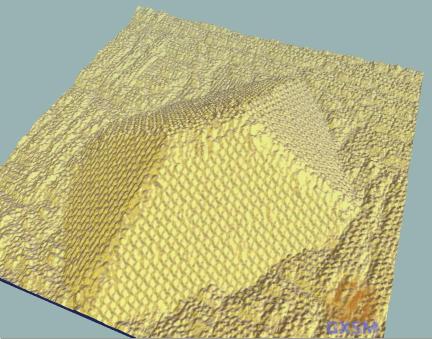GXSM - History
There is a long history and there were many platforms it has migrated through. The Original purpose of the software was the control and data acquisition needed by STM only. Rooted at the "Institut für Festkörperphysik" in Hannover, Germany led by Prof. Dr. Martin Henzler. That time the corresponding GXSM project founder Percy Zahl (P.) was about to start his Diploma Thesis in the Group of Prof. Dr. Michael Horn-von Hoegen (now at University of Duissburg-Essen). The oldest historic remainings (from around 1994) are really only some math kernel functions for image processing and the support of the old .dat-format remaining up to now. It was running on a OS/2 2.X's plain terminal and the graphics were put on special high resolution 20inch monitor. L. Anderson rewrote it to a first GUI version using the OS/2 (later Warp) Presentation Manager (PM), it was called "pmstm" but there was no hardware support.
R. Kumpe wrote the first module supporting a card from Data-Translation.
P. wrote lots of new PM code and added the support for a new DSP based hardware. We used a TMS 320 DSP card from GBM/Innovative DSP called PC31. The very first DSP code ideas P. got from G. Meyer - many thanks for to him for all the learning material - he used it in conjunction with some DOS based Turbo-Pascal code.
The DSP was running the feedback loop to regulate the tunnelling current to constant and additionally it also does the scanning and data acquisition in real-time. Also a automated tip approach was implemented.
The OS/2 PM version was used until 1997/8 - then I setup a new and more object oriented version using Linux and the XForms library - while R. Hild does his diploma work he got new versions every time he complains about some bugs... . This version, called Xxsm was about the birth of the later GXSM, is now in a very stable state, but the XForms library got out dated. So P. decided to move to the modern Gnome/Gtk+ and so we got the new GXSM.
GXSM is developed since summer 1998 and has grown, lots of new filters and control panels were added. Also full SPA-LEED support was included by merging some code from the experimental xforms "xspa" version... This fragmentation was not longer acceptable due to the huge code, so later -- after finishing my PhD thesis -- I began in beginning of December 2000 with the design of a Plug-In structure and started turning code over into Plug-Ins. The same time the decision was made to make GXSM public, open source/GPL and available via SourceForge.net. From then on a web based code management and more international developing started.
In beginning of 2001 I added support for 2.4.x kernels and devfs, some more Plug-Ins and improved the GXSM configuration in many ways...
 Lots of improvements, much more sophisticated spectroscopy
(probing) support and some new Plug-Ins from Im/Export of foreign data
formats to data analysis and instrument controls were added and
improved. And now we have a multidimensional data acquisitions
system, able to acquire several different channels of possibly layered
2D data field (num channels X num values/channel and position X num
pixels in x*y).
Lots of improvements, much more sophisticated spectroscopy
(probing) support and some new Plug-Ins from Im/Export of foreign data
formats to data analysis and instrument controls were added and
improved. And now we have a multidimensional data acquisitions
system, able to acquire several different channels of possibly layered
2D data field (num channels X num values/channel and position X num
pixels in x*y).
A nice 3D view using Mesa/GL was created as goodie... see image on right (Ge Hut on Si 100)
End 2002 GXSM was ported to Gnome 2, this was the beginning of GXSM-2.
At the same time the new class of DSP hardware "Signal Ranger" support and a complete new DSP SPM software was created.
2003 GXSM is still expanding in functionality and in usage around the world -- which delights the GXSM team!
Beginning 2004: experimental Hardware-Interface(HwI)-PlugIn design. Summer 2004, new HwI is working well and has replaced the core code. The SRanger/GXSM-2 vector probing method is under evaluation and testing. SRanger USB support for 2.6.x kernels.
2005/2006: SR and CoolRunner IO with Counter/Timer support for extra 32bit counting channel. The VectorProbe was invented and developed further as a very versatile "probe" tool to handle everything from simple I/V type spectroscopy, manipulation to tip forming and many more complex "probe" variants.
In 2007 the basic Linux support for the SR-Mk2 was laid out, but missing a SPM dedicated Analog IO. This changed by the end of 2008: The new SR2-A810 analog IO expansion was finished by SoftdB, a dedicated analog IO module for SPM. The first prototype was given to the hands of the GXSM developer and is now fully supported, including two independent counter/timer channels. It got commercially available from approximately February 2009 and is currently (speaking of 2012) still up-to-date.
However the next generation MK3-Pro/A810 with included PLL capability and more computing power is available since 2011 and SPM code porting is about finished. It will be ready for the most demanding needs of the future to come. And it is already in a testing stage today. Also SoftdB, our independent hardware supplier and close point of contact for any needed in-depth support is this year expanding the SPM product line available.


